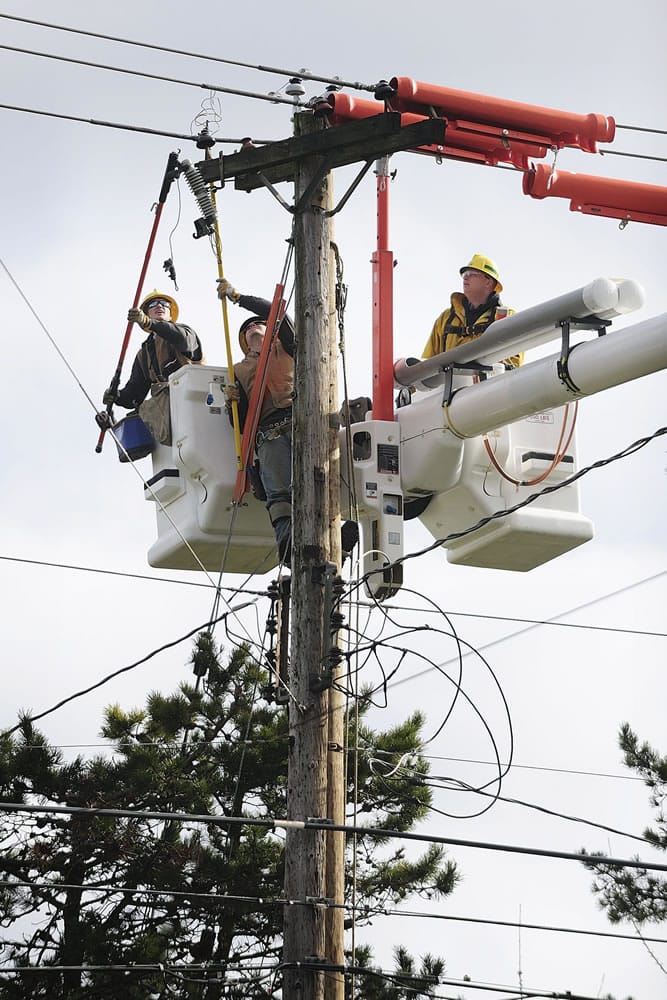The utility’s compensation has climbed because it has added employees some to handle a workload that has increased despite the economic downturn as people continue to demand power for their homes and companies, others to comply with a complicated, voter-approved energy law and a tough new power-management contract.
In fact, if you exclude the higher-paid workers the utility brought on to weave its way through the tangle of requirements, its average pay went up by 15.7 percent from 2005 to 2010 much closer to the countywide average.
Failure to add the staff necessary to comply with the new regulatory and contract environment would have put the utility at risk for “significant penalties,” said Erica Erland, communications manager for Clark Public Utilities. Instead, the utility has managed the changes smoothly, she said, with a recent major audit of the utility’s operations including dispatch, power supply and cybersecurity finding zero problems.
High skills, high pay
When compared to the broader economy, the utility industry, because of the highly technical work involved, has long been skewed toward jobs that pay more, according to Scott Bailey, regional economist for the Washington State Employment Security Department.
The utility industry’s higher average wage “is a product of both the over-representation of high-wage, high-skilled positions and the relatively low level of low-skill, low-wage positions,” Bailey said.
A utility isn’t the same as, say, the retail business where a bad economy equals fewer customers and lower revenues, thus potentially triggering cuts in pay and benefits, or layoffs, Bailey said. On the contrary, utilities operate in a relatively protected market. “Everybody’s still using power,” Bailey said.
That’s been the case with Clark Public Utilities. In fact, between 2005 and 2010, the utility added more than 10,000 electric customers, despite the late-2000s financial crisis.
The economic crash “didn’t mean one thing as far as lowering our workload here,” said Wayne Nelson, general manager and CEO of Clark Public Utilities.
High-paid staff added
Between 2005 and 2010, the utility hired 27 new employees, in part to handle the influx of customers.
Some of those new employees were added to specifically address onerous new industry and regulatory requirements, and those workers came with a lot of brainpower the kind that fetches high pay and benefits.
Meanwhile, Clark Public Utilities employs fewer people in low-skilled, low-wage positions than in the past and fewer than work in the county as a whole.
Many years ago the utility eliminated all of its meter readers low-pay, entry-level positions in favor of an automated system.
“What you have,” Nelson said of his staff, “(are) lawyers, accountants, engineers, power supply people, people degreed in engineering or in economics.”
Because of the types of jobs at the utility, matching its compensation with Clark County’s overall workforce is an “apples and oranges comparison,” Nelson said.
One of the utility’s new challenges is a mind-numbingly difficult contract from the Bonneville Power Administration under which Clark Public Utilities must balance its own energy load. That means it’s had to take on the additional risks that come with selling and purchasing power, and ensuring customers receive reliable and affordable power.
The other requirement is Initiative 937, the statewide, voter-approved renewable energy law that requires large utilities to obtain power from renewable sources but not from conservation or hydropower spurring Clark Public Utilities’ costly purchase of wind power. The law, approved in 2006, also carried new conservation measures in tow.
Among the jobs created to navigate this thicket of new complexities is the utility’s power manager position, which oversees the power supply under the new BPA contract and under the new I-937 requirements.
The job pays a salary of $140,000. Across the country, people in this position earn $112,408 to $171,314, according to the American Public Power Association’s survey of management salaries.
Then there’s Clark Public Utilities’ senior manager of energy technologies and services, which manages state-mandated conservation activities and oversees key industrial and commercial accounts.
The salary? $133,656. The salary range for the position is $118,390 to $152,252, according to the APPA.
Erland, the utility’s spokeswoman, said about $4 million of the utility’s payroll growth from 2005 to 2010 is directly attributable to the complexities that have arisen in a vastly changing energy market.
When you subtract the cost of complying with those industry changes, Erland said leaving only the labor costs associated with the growth in customers the increase in the utility’s wages and benefits from 2005 to 2010 “is in line” with the overall Clark County labor market.
Just over 100 of the utility’s total workforce of more than 380 people belong to the International Brotherhood of Electrical Workers. Those journeyman line workers also are in a high-skilled trade, Nelson said, “which has a decreasing number of qualified people to choose from.”
For a journeyman line worker at Clark Public Utilities, base pay has climbed 18.9 percent, to $77,501 from 2005 to 2010. By contrast, at Snohomish County Public Utility District in Everett, a journeyman line worker’s base pay has increased 25 percent, to $84,052 from 2005 to 2010.
The increase is a function of several factors, according to experts. The collective bargaining process puts some upward pressure on wages. Private and public utilities make comparisons of line worker wage rates to help determine a range. And a limited supply of such workers who are highly skilled coupled with strong demand for them also makes their pay climb.
The overtime Clark Public Utilities spends on responding to special demands, such as restoring power after big storms, also influences how high the utility’s labor costs are in a given year, said Rick Dyer, director of finance for the utility.
Type of job matters
Bailey, the regional economist, cautioned against contrasting different industries’ pay and benefits. “It’s really the occupations in those industries that matter,” he said. “When you hire somebody, you hire them by occupation and the particular skill level and education that you need.”
“You might look at how they compare with a private utility’s wages,” he said.
Statewide, the average wage of a private utility worker excluding benefits is $85,000, according to Bailey. By contrast, the average wage (excluding benefits) of a public utility worker is $80,000.
As to benefit packages at public and private utilities, Bailey said, “I would guess that the benefits are comparable.”
Rob Hamilton, a Portland-based division director for Robert Half International the global staffing firm specializing in accounting, finance and information technology said utilities generally pay very well and offer “good benefit packages” based on the types of skilled workers they’re competing to hire.
Clark Public Utilities employees also have access to the state’s public employee retirement system, which is offered to local government employees.
Competitive wages
To help decide how to compensate its workers, Nelson said, the utility collects and analyzes salary data in the region for all occupations that are comparable to the utility’s occupations.
The utility sets salary ranges using multiple surveys, including from the utility industry and from cross-industry surveys in the public and private sectors.
“We’re not operating in an insular way,” said Erland, the utility’s spokeswoman. “We’re looking at the overall economic landscape.”
Every one of the utility’s employees is paid within a salary range based on what “the market is paying people in comparable positions at the present time,” Nelson said.
Neil Neroutsos, spokesman for the Snohomish County Public Utility District, said utilities across the state face similar challenges in attracting talented workers.
“You’ll see utilities that have very large apprenticeship programs,” he said. “You’re trying to create programs that educate people and get them into a skilled system.”
The average worker at Snohomish County’s public utility district made $101,702 in wages and benefits in 2010 (roughly $3,100 less than at Clark Public Utilities).
Neroutsos said that as utilities modernize, moving to smart-grid technology, the types of skills utilities look for will change accordingly. “There are those forces at work,” he said.
But one thing hasn’t changed, he said: Utilities, both public and private, continue to compete with each other for talent which contributes to the ratcheting up of pay and benefits.




